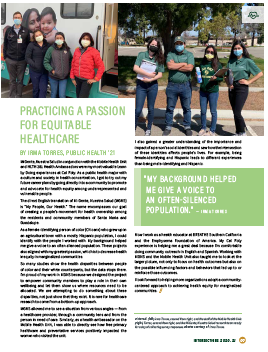Practicing a Passion for Equitable Healthcare

By Irma Torres, Class of '21
Mi Gente, Nuestra Salud in conjunction with the Mobile Health Unit and HLTH 281 Health Ambassadors were my most valuable Learn by Doing experiences at Cal Poly. As a public health major with a culture and society in health concentration, I got to try out my future career plans by going directly into a community to promote and advocate for health equity among underrepresented and vulnerable people.
The direct English translation of Mi Gente, Nuestra Salud (MGNS) is “My People, Our Health.” The name encompasses our goal of creating a people’s movement for health ownership among the residents and community members of Santa Maria and Guadalupe.
As a female-identifying person of color (Chicanx) who grew up in an agricultural town with a mostly Hispanic population, I could identify with the people I worked with. My background helped me give a voice to an often-silenced population. These projects also aligned with my greatest passion, which is to decrease health inequity in marginalized communities.
MY BACKGROUND HELPED ME GIVE A VOICE TO AN OFTEN-SILENCED POPULATION.
— Irma Torres
So many studies show the health disparities between people of color and their white counterparts, but the data stops there. I’m proud of my work in MGNS because we designed the project to empower community members to play a role in their own wellbeing and let them show us where resources need to be allocated. We are attempting to do something about these disparities, not just show that they exist. It is rare for healthcare research to come from a bottom-up approach.
MGNS allowed me to see a situation from various angles — from a healthcare provider, through a community lens and from the person in need of care. Similarly, as a health ambassador on the Mobile Health Unit, I was able to directly see how free primary healthcare and preventative services positively impacted the womxn who visited the unit.
Now I work as a health educator at BREATHE Southern California and the Emphysema Foundation of America. My Cal Poly experience is helping me a great deal because I’m comfortable doing community outreach in English and Spanish. Working with MGNS and the Mobile Health Unit also taught me to look at the larger picture, not only to focus on health outcomes but also on the possible influencing factors and behaviors that led up to or reinforce those outcomes.
I look forward to helping more organizations adopt a community- centered approach to achieving health equity for marginalized communities. //
Read more about Healthy Communities in An Innovative Response and Filling the Gaps





